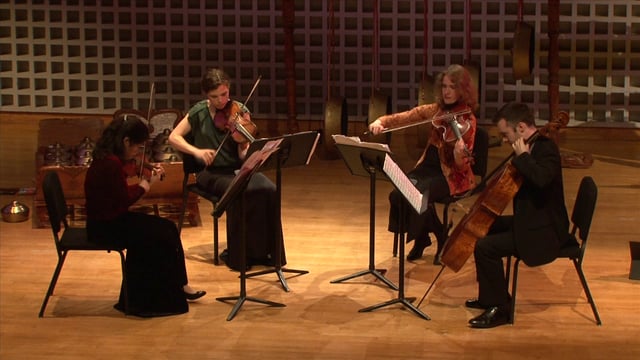Momenta Quartet makes hell an enjoyable ride
The second concert of the Momenta Quartet’s new self-titled festival had the foreboding title, “The Concert from Hell.” The evening’s curator, first violinist Emilie-Anne Gendron, explained in the program notes that her idea came from her being “a devoted fan of psychological thriller and horror movies.” She added that she is “attracted to anything that pushes us to our internal limits.”
According to Gendron, the music she programmed at the Tenri Cultural Institute explored “a few of the dark, disturbed, deranged musical worlds that composers have envisioned in the last century.” With a violin sonata from Ysaÿe, and quartet music by Glass, Crumb, and Julián Carillo—and a cameo from Charles Ives—the response to her statement was best left to individual experience.
Gendron was not just thinking of horror, but “obsession, melancholy, monotony,” The concert did touch on those hells, and in that sense it satisfied her argument. Gendron, violinist Adda Kridler, violist Stephanie Griffin, cellist Michael Haas and two guest musicians played with verve, intellect, expression, and impressive instrumental skill. There were vivid musical depictions of myriad experiences and psychological states, and there as monotony—a conceptual victory but not a musical one.
Gendron herself opened the concert with Ysaÿe’s Sonata for Solo Violin. Op. 27, No. 2, in which Ysaÿe confronts Bach, a fairly terrifying prospect for most composers. The piece begins with the Prelude to Bach’s Partita for Solo Violin No. 3, quickly shakes it off to start its own music, returns to Bach again, back and forth through the anxiety of influence. What really matters is how Ysaÿe uses the forms and structures like the Sarabande, variations—on the Dies Irae chant—and counterpoint to make Bach’s values his own.
To this he adds introspective chromaticism and substantial technical challenges, and Gendron obliged with clear articulation, certain rhythm, and exact intonation. She was also expressively agile, running the gamut of Ysaÿe’s mercurial doubts and triumphs.
Carillo was an important explorer of micro-tonality in the early 20th century, and Momenta played his Eighth String Quartet in Quarter-Tones, from 1958. This three-movement piece initially promised an intriguing vision of hell. It opens with a diatonic fanfare and then switches to a sequence of rising and falling quarter-tone phrases, and the initial juxtaposition is unnerving enough to flip the stomach over. But then Carillo repeats this technique, and one finds the ear has adapted and that the quarter-tones are no longer remarkable, except for the beautiful notes they find in between half-steps.
The piece grows monotonous quickly. Worse, it is redundant, using only two ideas—rising and falling phrases, diatonicism and microtonality—throughout. The repetition and duration can’t disguise the lack of substance. Momenta played it like it was great music, but even they couldn’t make it great.
Much better–and arguably great–was Glass’ String Quartet No. 2, “Company,” which opened the second half. This is some of Glass’ most haunting music, and the moving expressive weight that Momenta gave it explored the horror of loneliness. As with the previous night’s performance, they play Glass with a pleasing, sober firmness.
The big piece on the program was Crumb’s Black Angels, a 20th-century classic that also appears on the soundtrack to The Exorcist and has inspired countless imitators among horror film composers. The piece was originally a response to the Vietnam War, but seems even more relevant in today’s age of endless war and violence.. The opening Threnody I: “Night of the Electric Insects,” is music for an era in which pilotless drones fill the skies.
Black Angels is severe, disturbing, imaginative, and filled with uncanny abstract rituals, all things that stimulate a sense of savage beauty. Crumb drags the past forward to serve the present, through his own use of Dies Irae, filtered through Berlioz, and the transformation of music from Schubert’s Death and the Maiden into a Renaissance pavane.
Momenta began the music with a brittle touch. They produced a strong pulse, so much so it seemed to get in the way when the musicians put down their instruments to play percussion. Without following Crumb’s stage diagrams in Tenri’s tidy gallery space, there was still an inherent choreography in the notes, yet things seemed to be moving just a little too fast. Then in the Danse Macabre that rounds off the opening “Departure” section, Gendron found the perfect pace while using her left hand to pluck out the Dies Irae tune, her right hand accompanying with a maraca.
After that, the performance smoldered steadily until it caught absolute fire in the “Return.” The playing was intense and powerful. The pavanes were a little shaky—the violinist and violist have to hold and play their instruments like gambas—but that added a poignant expression. A welcome hush fell over the audience at the end.
Appropriately, Charles Ives lightened the mood, via “Hallowe’en” from his Three Outdoor Scenes. This is, literally, party music, and since it’s Ives, by the time the music starts the hard cider is all gone and everyone is a little out of control. The eminent pianist Gil Kalish was on hand for a cameo to elegantly bash chords on the piano, and violinist Gregory Fulkerson was in the wings, pounding the optional drum.
The Momenta Festival continues at Tenri Saturday with music by Crumb, Boccherini and Debussy, and concludes Sunday with a world premiere from Gordon Beeferman and pieces from Yusef Lateef and Arthur Kampala. All concerts are 8 p.m.momentaquartet.com







